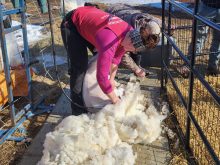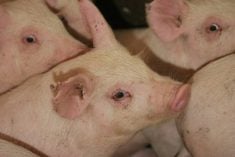BVD is adding value to the CCIA.
“We pledged we’d add value to the database and this is our first big step in that direction,” says Brett McConkey of the Canadian Cattle Identification Agency.
Bovine viral diarrhea virus causes abortions, premature births and stunted calves that have underperforming immune systems. Calves can also experience up to 10 kilograms of reduced weaning weight.
The CCIA database now offers an option to producers when they age register their calves. Growers taking part in the Boehringer Ingelheim Express vaccination program can enter that fact in the database.
Read Also

Charges laid after cattle theft
Saskatchewan RCMP lay two charges against a man after six cattle went missing.
Producers can then use the system to verify their dams were vaccinated using Express 5 or 10 way, with or without the Haemophilus somnus bacterial protection.
The dam vaccination four to eight weeks before breeding should provide protection from BVD. If a BVD persistently infected calf is discovered after producers have used the Express product, Boehringer Ingelheim will buy the calf at a post weaning market price.
Lee Irvine of the veterinary drug maker said his company hopes feedlot and replacement heifer buyers will see the added value in the vaccinated animals and pay cow-calf producers a premium.
In exchange for an arrangement to use the system, Boehringer Ingelheim paid for upgrades to the CCIA database.
McConkey said the database is still confidential and double blind, so the drug maker can’t access the name of the producer if confidentiality is requested.
Doug Myers, a veterinarian with Boehringer Ingelheim, said cattle producers should be able to pay for the cost of the vaccine through increased weaning weights, reduced calf losses and improved breeding results in cows.
Cheryl Waldner, a research scientist and associate professor at the Western College of Veterinary Medicine in Saskatoon, said vaccination for BVD has proven effective in controlling the virus.
“This delivers for the cow-calf producer, not just the feedlot,” she said. “But it pays big dividends at the feedlot. If one of those little virus factories (persistently infected BVD calf) gets into your operation, it can cost you big time.”
A multi-year study of 33,000 animals in 205 beef cattle herds across the Prairies looked at major health issues in cow-calf production and indicated that vaccination against BVD was effective and paid dividends throughout the production chain.
McConkey said the CCIA worked with Boehringer Ingelheim for more than a year to develop the program.
Waldner said on average persistently infected calves that shed BVD at the feedlot reach a market weight that is 70 kilograms lighter than other calves and they are six times more likely to be treated for other diseases.
Most of these animals don’t live longer than one or two years, but during their lifetime, persistently infected calves can do a lot of damage.
If the calves come into contact with pregnant cows, they can cause abortions, congenital defects and decreased productivity in the herd, creating a biosecurity problem.
To access the Boehringer Ingelheim CCIA program, producers use a code they receive from their veterinarian when they buy the vaccine. The code becomes active and can be entered into the CCIA database for a period of nine months, beginning nine months from the date of purchase because of gestation.
Irvine said he hopes the idea of using the CCIA database to add value will catch on in the industry.
“I can see other uses down the road, but we need the chain to do their part to pay for the added value that they receive when cow-calf producers step up and do the right thing,” he said.
For more information, call 800-263-5103 ext. 4499.
















